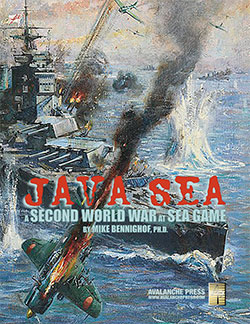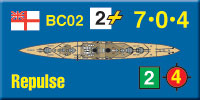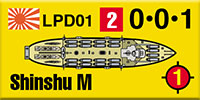| Second World War at Sea: Java Sea
Scenarios & History, Chapter One
By Mike Bennighof, Ph.D.
February 2024
 Our Second World War at Sea series covers naval combat in all theaters of the war with one set of rules – One Rulebook to Rule Them All. Each campaign is unique, shaped by history and geography, and that’s true of the Japanese advance into South-East Asia in late 1941 and early 1942, the theme of Second World War at Sea: Java Sea. Our Second World War at Sea series covers naval combat in all theaters of the war with one set of rules – One Rulebook to Rule Them All. Each campaign is unique, shaped by history and geography, and that’s true of the Japanese advance into South-East Asia in late 1941 and early 1942, the theme of Second World War at Sea: Java Sea.
On the surface, the campaign shouldn’t make for a very interesting game; the Japanese applied overwhelming superiority. But then they spread that superior force across a huge swath of the Earth’s surface, following the principle of applying just enough force to accomplish a given mission and no more, almost inviting the out-numbered Allies to concentrate and strike back.
That’s evident in the first chapter of Java Sea, “The Loss of Force Z.” The British government hoped to show its resolve to stand against Japanese aggression by sending a surface action group of a fast modern battleship and rebuilt battle cruiser to the Far East. In response, the Imperial Japanese Navy’s land-based bomber squadrons began practicing more intensely for attacks against large surface ships.
Those bombers are the crucial difference. The Japanese did not alter their invasion plans when the British Force Z arrived, and the covering force is only barely adequate at best. If the British can force a surface action, their odds aren’t that bad. They lack destroyers almost as badly as they do fighter planes, but the two Japanese covering forces (it wouldn’t be the Imperial Navy if they didn’t slice up their fleet into many separate task forces) are built around two rebuilt battle cruisers and two heavy cruisers on one hand, and six heavy cruisers without anything larger on the other. They do have the powerful Special Type destroyers, however.
 The Second Edition games of Second World War at Sea are built around choices. The choices the commanders made on the spot, and those the players make when placed in the same situation. So that’s how Java Sea, the game, is built as well. The Second Edition games of Second World War at Sea are built around choices. The choices the commanders made on the spot, and those the players make when placed in the same situation. So that’s how Java Sea, the game, is built as well.
In the actual events, British Admiral Tom Phillips led Force Z (the fast battleship Prince of Wales, battle cruiser Repulse and three destroyers) out to attack the Japanese landing forces with the hope of getting among the transports at dawn, and receiving fighter cover to fend off Japanese bombers. Phillips is often portrayed as a dilettante, and it’s true that he had not been to sea since the Great War, and had implicitly accused sea officers of cowardice from behind his desk in Whitehall (including his own flag captain, John Leach). But was his sortie a suicide mission, or did it have a reasonable chance of success?
We can use the game to at least get some insight into that. I don’t think his odds of success were very high, but given the situation and the Royal Navy’s culture of direction action (plus his own unfortunate statements after the Battle of the Denmark Strait and Cape Spartivento) I also don’t see that he had any choice but to pursue the Japanese. The first chapter of Java Sea, the game, is built to let you, the player, reach your own conclusions.
The game includes an operational scenario (that is, one involving the operation map where task forces move across the South China Sea and nearby waters) covering the entire operation, or what would have been the entire operation if waves of Japanese bombers hadn’t ended Sir Tom’s adventure somewhat early.
We then break that down with a “snapshot,” picking up the action just as Phillips turned west to attack the Kota Bharu beachhead. His course until that turn held very good chances of an encounter with either of the Japanese surface action groups. The Allied player can choose to seek out the Japanese surface ships, or follow Force Z’s actual route westwards (which, without fighter cover, is a very dangerous game).
 The chance of picking up fighter cover is very important here, and not many popular histories make this clear enough (though the Japanese National Defense College’s thorough study of the campaign is adamant on this point). The Japanese bombers had an enormous range, more than the British credited them – though after they struck Singapore in the first hours of the war, this was no longer a secret. But the Japanese fighters, though they greatly out-ranged their British counterparts, could not reach the invasion beaches. The Japanese provided cover for their transports with seaplane fighters, but these planes had no coordination with the bomber squadrons and could not have provided escorts. Even the crapulent Brewster Buffalos and outdated Hurricanes that the Royal Air Force operated in Malaya would have had a chance to turn back the un-accompanied bombers. But instead, they stayed home, only arriving on the scene after Force Z’s destruction. The chance of picking up fighter cover is very important here, and not many popular histories make this clear enough (though the Japanese National Defense College’s thorough study of the campaign is adamant on this point). The Japanese bombers had an enormous range, more than the British credited them – though after they struck Singapore in the first hours of the war, this was no longer a secret. But the Japanese fighters, though they greatly out-ranged their British counterparts, could not reach the invasion beaches. The Japanese provided cover for their transports with seaplane fighters, but these planes had no coordination with the bomber squadrons and could not have provided escorts. Even the crapulent Brewster Buffalos and outdated Hurricanes that the Royal Air Force operated in Malaya would have had a chance to turn back the un-accompanied bombers. But instead, they stayed home, only arriving on the scene after Force Z’s destruction.
I also wanted to explore a very different option, one that was discussed both in London among Phillips’ superiors and between Phillips and Admiral Thomas Hart, commanding the U.S. Asiatic Fleet. Hart sent his cruisers and destroyers, terribly outnumbered by the Japanese, southward into the Dutch East Indies to avoid the initial Japanese strikes and strike back from unknown locations.
So we have a scenario based on this option as well, which greatly changes the game. A pair of capital ships give the Allied player many more options, and more importantly, change the risk calculations for the Japanese player. Those troop convoys guarded by a light cruiser and a handful of destroyers, or even a couple of minelayers and subchasers, become even more vulnerable to Allied surface attack. And the actual Japanese leaders probably would have carried through with them anyway; those plans had been made before Prince of Wales and Repulse went to the bottom of the South China Sea.
With a semi-free setup, the Allied player has more options for the initial placement of Force Z and the assorted cruisers and destroyers that otherwise begin at Singapore. It doesn’t change the imbalance of air forces, and it doesn’t put the Allied ships in better position to repel the invasion (the Japanese came right at Malaya). It does induce much more tension, particularly for the Axis player.
And of course we have battle scenarios. These take place just on the Tactical Map, the place where ships fight each other with guns and torpedoes. The battle scenarios in Second World War at Sea (and its sister series, Great War at Sea) are a means to look at what could have happened during any given operation, not just what did happen. Force Z was, as Winston Churchill hoped, a potent surface action group. It was not, as Churchill also thought, powerful enough to defeat the Japanese Second Fleet by itself.
Among the battle scenarios in Chapter One, there’s the historical air strike on Prince of Wales and Repulse, which is going to be hard on the Allied player. We have an Allied attack on the Kota Bharu landings, which is going to be hard on the Axis player (like I said before, the Japanese didn’t go overboard with escorts for their invasion convoys).
And we get to fight out the potential high seas engagements: Force Z against the Japanese battleships, and against the Japanese heavy cruisers. You fight like you train, and the Japanese battleship gun crews just didn’t train very often. But the cruiser crews did so relentlessly, and though Prince of Wales has armor that will keep out the heavy cruisers’ shells, Repulse does not. And then you get to fight with the American destroyers supporting Force Z; Phillips asked Hart for them, Hart agreed, and they were on their way to Singapore when they received word that Force Z was no more.
So that’s what we’ve got in Chapter One: The Loss of Force Z.
You can order Java Sea right here.
Sign up for our newsletter right here. Your info will never be sold or transferred; we'll just use it to update you on new games and new offers.
Mike Bennighof is president of Avalanche Press and holds a doctorate in history from Emory University. A Fulbright Scholar and NASA Journalist in Space finalist, he has published a great many books, games and articles on historical subjects; people are saying that some of them are actually good.
He lives in Birmingham, Alabama with his wife, three children, and new puppy. He misses his lizard-hunting Iron Dog, Leopold.
Want to keep Daily Content free of third-party ads? You can send us some love (and cash) through this link right here. |
